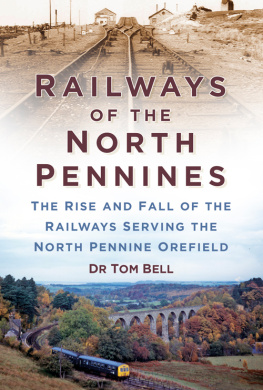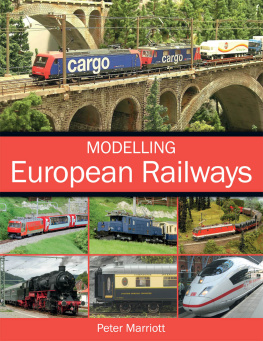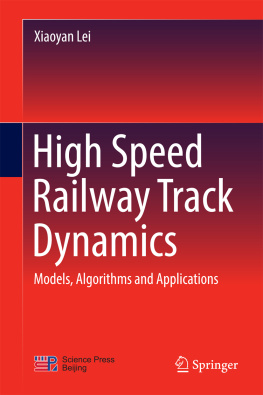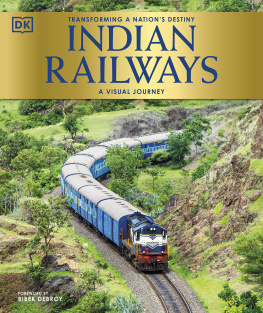RAILWAY MANAGEMENT AND ENGINEERING
To the memory
of my father Aristide
Railway Management and Engineering
Fourth Edition
V.A. PROFILLIDIS
Section of Transportation,
Democritus Thrace University, Greece
V.A. Profillidis 2014
Fourth revised edition
All rights reserved. No part of this publication may be reproduced, stored in a retrieval system, or transmitted in any form or by any means, electronic, mechanical, photocopying, recording or otherwise without the prior permission of the publisher
V.A. Profillidis has asserted his right under the Copyright, Design and Patents Act, 1988, to be identified as the author of this work.
Published by
Ashgate Publishing Limited
Wey Court East
Union Road
Farnham, Surrey
GU9 7PT England
Ashgate Publishing Company
110 Cherry Street
Suite 3-1
Burlington, VT 05401-3818
USA
Ashgate website: http://www.ashgate.com
A catalogue record for this book is available from the British Library
Profillidis, V. A. (Vassilios A.)
Railway Management and Engineering / by V.A. Profillidis. -- Fourth edition.
pages cm
Includes bibliographical references and index.
1. Railroad engineering. 2. Railroads Management. I. Title.
TF145.P76 2014
385.068dc23 2013037783
ISBN 9781409464631 (hbk)
ISBN 9781472407788 (ebk-ePUB)
Contents
10.3.2. Chemical
composition
Foreword
by
Prof. A. Lpez Pita
Catalonia Polytechnic University
Member of the Spanish Royal Academy of Engineering
The publication in 2006 of the book Railway Management and Engineering, by Professor Profillidis, was without doubt an inspired decision. In comparison with his previous publication Railway Engineering, which appeared in the nineties, it meant the inclusion of a more global vision of the railway as a mode of transport.
Seven years have passed since the adoption, by Professor Profillidis, of the aforementioned vision in his publication and he now presents us with a new edition of his successful book. To be able to produce an appropriate foreword for the content of this book, I have taken the liberty of analyzing the existing differences between the 2006 edition and the new one.
The conclusion I have reached, after carrying out the aforementioned comparison, is that the strong points of the previous version are confirmed and its more concise sections have been thoroughly strengthened. As a result, Professor Profillidis work deserves our recognition.
I would like to highlight, in the context of the positive assessment of the publication, the attention paid to dealing in more depth with railway and transport, with its own chapter. By knowing only the frame of reference, one can make significant advances. In the aforementioned chapter the latest available statistical data are included, a fact that enables us to better appreciate the progress made in recent years, in aspects as key as energy costs.
In the times we live in, it is now even more necessary to include the financial aspects that dominate the railway business in the decision making process. For many years civil engineers have paid preferential attention to the solving of technical problems, forgetting, at least in part, the financial component.
That is why the book by Professor Profillidis will enable readers to have, in just one publication, an account of railway technology on the one hand and management of the commercial and financial operation on the other. To my knowledge, there is no book that offers this dual perspective in English technical literature.
Finally I would like to highlight the treatment given in the books final chapter concerning the effects of the railway on the environment. With regard to the previous edition, the content has been thoroughly improved, so much so that we can truly speak of it as a new edition. At a time of special awareness and concern about the environment, in the broadest sense, paying greater attention to these aspects is, without doubt, a very wise choice.
Therefore, I will conclude by thanking Professor Profillidis for having made this new publication available to the university and professional community. It is useful both for those who are taking an interest in the railway as a mode of transport for the first time and for those professionals who wish to update their knowledge.
I am convinced that readers of this book will be satisfied not only by its content but also by the clarity with which it has been written.
Preface
In a rapidly changing world, with increasing competition in all sectors of transportation, railways are in a period of restructuring their management and technology. As new methods of organization are introduced and commercial and tariff policies change radically, a more entrepreneurial spirit is required. At the same time, new high-speed tracks are being constructed and old tracks renewed; high-comfort rolling stock vehicles are being introduced, logistics and combined transport are being developed. Awareness of environmental issues, daily highway and airport congestion and search for greater safety give railways a new role within the transportation system. Indeed, railways operate in 2011 1,028,723 kilometers of lines worldwide (of which 272,447 kilometers are electrified), with about 7 million railway employees and transport 31.47 billion passengers (2,885 billion passenger-kms) and 11.36 billion tons (9,669 billion ton-kms) of freight.
Meanwhile, methods of analysis have significantly evolved, principally due to computer applications, new technological achievements and new ways of thinking and approaching old problems.
Thus, it has become necessary to come up with a new scientific approach to tackle management and engineering aspects of railways, to understand in-depth the causes and consequences of the various situations and phenomena and to suggest the appropriate methods and solutions to solve the various emerging problems.
This fourth edition of the book aims to cover the need for a new scientific approach for railways. It is intended to be of use to railway managers, economists and engineers, consulting economists and engineers, and students of schools of engineering, transportation and management.
This wide range of intended readership has led me to divide the book in three distinct parts.
The first six chapters deal with the management of railways and more particularly with issues related to the position of railways in the transport sector, new technological achievements such as high-speed and magnetic levitation trains, policy and legislation for railways, methods of forecast of rail demand, costs and economics of railways, methods of pricing, management of railways, and the separation of infrastructure from operation.
The next eleven chapters deal with the track and more particularly with issues related to the mechanical behavior and design of the track system and of its various components (rails, sleepers, ballast subgrade), track layout, transverse effects and derailment, switches and crossings, laying and maintenance of track, and slab track.
The last five chapters deal with rolling stock, signaling and environmental topics and more particularly with issues related to train dynamics, rail tunnels, design and operation of rolling stock, diesel and electric traction, signaling and safety, interoperability, rail traffic management system, and the environmental effects of railways.
Each chapter of the book contains the necessary theoretical analysis of the topics studied, the recommended solutions, applications, charts and design of the specific railway component. In this way, the requirement for a theoretical analysis is met and the needs of the railway manager and engineer for tables, nomographs, regulations, etc. are satisfied as well.
Next page










